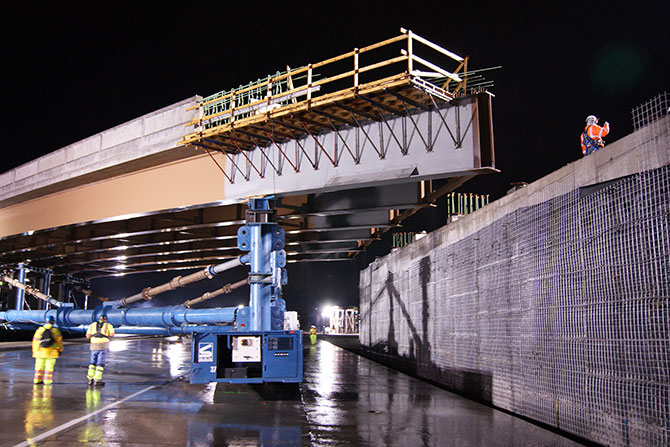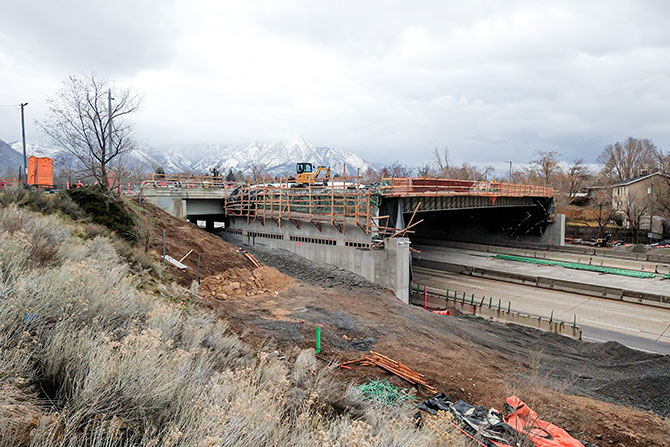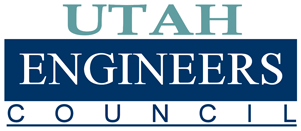Summer is the travel season: travel by plane, boat or, most commonly, by car. Parents drop their children off at summer camps, teenagers go on long road trips, couples drive to the airport to catch flights and families visit relatives. But summer is also construction season, so all these travelers often see orange- and yellow-vested crews working on the road.
Road work means delays from lane changes, reduced speeds and detours; the traffic delays and changes that come from road construction are the bane of summer months and often delay commutes as early as spring thaw and well into fall.
Nothing causes more delays than bridge replacements with limited widths for construction and swiftly moving traffic. The replacement of more than 43,500 deficient bridges in the United States,1 with only 63 in Utah,2 is complicated by the limited room for construction and traffic during the bridge replacement.
The replacement of a simple, 120-foot span bridge also includes repaving the approach slabs. The work takes an average of six to seven months with active traffic. That’s six to seven months of construction delays and changed traffic patterns.
Imagine condensing six or seven months of daily construction delays into a single weekend. Accelerated Bridge Construction makes that possible.
Accelerated Bridge Construction
Accelerated Bridge Construction (ABC) is an umbrella term for advanced bridge construction technologies. They “reduce the onsite construction time that occurs when building new bridges or replacing and rehabilitating existing bridges.”3 Many ABC methods allow bridge replacement or construction to occur in days or hours, including using precast bridge elements, sliding completed bridges into place, moving bridge girders and decks with self-propelled modular transporters (SPMTs), and performing bridge launches. The methods mentioned above have been used successfully in Utah over the past two decades.
One of the most frequently used ABC technologies is Prefabricated Bridge Elements and Systems (PBES). They are “structural components of a bridge that are built offsite, or near-site of a bridge, and include features that reduce the onsite construction time and mobility impact time that occur from conventional construction methods.”3 PBES can easily be divided into prefabricated elements and prefabricated systems.
The Federal Highway Administration defines a prefabricated element as a “single structural component of a bridge”3 that reduces the onsite construction time required if the component had been built onsite using conventional construction methods. These elements are usually repetitive members designed for multiple loads and locations to offset the fabrication cost.
Prestressed concrete girders are one of the most common prefabricated elements used in Utah. They can be cast and prestressed at precast concrete plants local to Utah before being shipped to the bridge site for placement. Engineers also often use precast deck panels for bridges over active railroads or highways to reduce the construction workers’ time over traffic or trains. The concrete prefabricated elements benefit from the controlled conditions inherent in prefabrication. The additional cure time allows the structural elements to be placed on-site at full strength.
Prefabricated systems consist of “an entire superstructure, an entire superstructure and substructure, or a total bridge that is procured in a modular manner such that traffic operations can be allowed to resume after placement.”3 A bridge consists of a superstructure and a substructure. The superstructure consists of the bridge girders, deck and any parapets or walls resting on the deck. The substructure consists of the bridge columns, abutments, and foundations. Prefabricated ABC systems can be “rolled, launched, slid, lifted or otherwise transported into place” through various methods. A separate construction phase is generally not needed after the bridge is in place.3 Some of the ABC prefabricated systems recently used in Utah are bridge slides, SPMTs, and bridge launches. Slide-In Bridge Construction (SIBC) can be used with prefabricated systems, but the Federal Highway Administration considers SIBC to be a different type of ABC technology.
SIBC can be a cost-effective method for using PBES and often has minimal impacts on traffic. A new bridge is built parallel to the existing bridge so that traffic can proceed as normal on the existing bridge. When the bridge construction is completed, the existing structure is demolished or removed so the newly constructed bridge can be slid into place. Bridge slides need a horizontal force to push or pull the bridge on a skid track with Hilman Rollers or Teflon pads with lubricant.4 Bridges that are moved using rollers must be moved on and off the rollers using jacks before they are finally lowered to their final elevation. Bridges moved with Teflon pads need to be constructed on elastomeric bearing pads that rest on top of the Teflon pads. With either method, the construction team often slides the bridge in stages. The construction team economically reuses rollers and pads during the move by transferring rollers and pads from behind the bridge to the front of the bridge. Although bridge slides can happen in a few hours, weekend closures for ABC are fairly common. The additional time is used to tie in the bridge and pave the surrounding area. The Utah Department of Transportation (UDOT) estimates that the cost of a bridge slide is approximately 20% less than the cost of using SPMTs. However, bridge slides are often built over the traffic like traditional construction and require the bridge to be constructed adjacent to the existing bridge.4
Prefabricated systems with SPMTs can provide efficient solutions for bridge replacements on high-traffic roads. They reduce traffic disruptions and increase safety for the workers and the traveling public due to bridge construction occurring in a staging area. Using SPMTs requires a staging area within close driving distance of the bridge location, and the fewer obstructions or grade changes, the better.5 SPMTs are “multi-axle, computer-controlled platform vehicles that can move bridge systems with precision to within a fraction of an inch.”5 A complex hydraulic jack system that ensures each axle is equally loaded allows vehicles to lift bridges and maintain the geometry while moving.5,6 These paired axle wheels can pivot 360 degrees so that the vehicles can move horizontally in any direction to bring a bridge superstructure to its final location. The SPMTs can be controlled by a single person using a “joystick-like, portable control panel … to drive, lift, steer, or brake” the large vehicles.6 SPMTs are often used in Utah due to the short construction season and the “need to avoid rush hour traffic impacts during bridge replacement projects.”7 As a result, UDOT has created standardized ABC detail to improve the efficiency of bridge replacements for the local design and construction firms.7
Some benefits of using prefabricated systems over prefabricated elements include the following. They minimize:
- Utility relocation
- Use or addition of the right of way
- Traffic phasing or staging
- Traffic detours or delays over an extended period
They also preserve the existing roadway alignment with no temporary alignments.
DOTs across the nation want to reduce the impact of construction on the traveling public. The short schedules and traffic benefits provided by ABC have driven their use. The decreased construction time and reduced mobility issues have become more important because many bridges are approaching the end of their service life, and the demands on transportation infrastructure are increasing.
ABC is known for improving work zone safety and site constructability. They also decrease traffic impacts, total project delivery time, on-site construction time and the work zone road user cost because all these benefits are interrelated.
The work zone is defined as a road segment in which maintenance or construction activities impact the number of lanes available to traffic or the characteristics of traffic traveling through the roadway segment. Work zone road user cost is defined as the “additional costs borne by motorists and the community at-large” due to maintenance or construction activities in the work zone. It includes travel delay costs, vehicle operating costs, crash costs, noise, business impacts and inconvenience to the local community.8
Travel delay costs can be quantified by the additional travel time required to pass through the work zone or use a detour and the monetary value of the travel time for a person or business.8 On the other hand, negative business impacts from roadway construction are harder to quantify. They include, but are not limited to, customer access and parking, delivery access, utility outages or disruptions, temporary or permanent loss of customers, decrease in sales and profit, and decrease in property or land values.8
All ABC technology increases work zone safety for construction workers and commuters by reducing on-site construction time and distractions. The reduction in on-site construction time reduces actual construction time and the number and length of road closures. It also removes lengthy detours and prevents construction crews from working adjacent to traffic. Crashes are an ever-present hazard in both road and bridge construction zones due to distractions and road changes, but “[44%] of bridge construction worker injuries involve a vehicle traveling through a work zone and two-thirds of these injuries are fatal.”9 While “the long-term presence of contractor-related equipment, labor and staging areas can present driver distractions,”3 using ABC with SPMTs provides an even higher level of safety. It removes traffic from the equation because construction teams complete bridge construction in staging areas away from live traffic.
The reduction in road closures, detours and traffic phasing often helps decrease the bridge planning time and reduce the bridge construction time and total project costs. Bridge construction time can be reduced by years with ABC, which directly decreases construction time and project cost. Total project costs for traditional construction can include a right-of-way acquisition, project administration, utility relocation and maintenance of traffic through lane or road closures and detours. Lane closures, or even road closures and the resultant detours, can quickly consume a project’s budget and cost more than the construction itself by the time the work has been completed. Any traffic detour can become prohibitively expensive when direct and indirect project costs are considered. This drawback is particularly apparent with “full-lane closures in large urban centers or on highways with high traffic volumes [that] can have a significant economic impact” on nearby businesses, industries and private homes.10
ABC methods can be helpful for bridge building in wetlands, near endangered species, or areas with low noise thresholds. Still, ABC may not be the best solution for bridges with multiple spans, bridges in areas where traffic volume is low, or when the bridge owners do not have the financial capability to pay for the additional costs incurred by using ABC. In those instances, conventional construction is often the better choice.
The substructures of many bridges in Utah constructed using ABC were built using conventional, sequential construction methods. Bridge supports bear on the foundations, so the foundations were placed before the bridge columns and abutments were constructed. Any reinforced concrete bridge supports would need to cure before any bridge girders could be placed. Then the concrete deck would be placed and require additional time to cure before any parapets could be placed on the deck or people could drive on the bridge deck.
One of the largest contributors to the time required for bridge construction using traditional methods is the time required to allow concrete to cure and reach full strength. Reinforced concrete is often used for bridge supports, abutments, girders and decks. A large section of the bridge closure schedule must be dedicated to concrete cure times because most of the cure times cannot occur in parallel with the construction sequence. The abutments and the bridge supports could be constructed and cured in parallel. Still, both those structural elements must be cured and reach the minimum calculated strength before any girders could be placed or constructed for the bridge. Once the girders are in place and (if made from concrete) cured, the concrete bridge deck must be placed and cured before the bridge can be used. Even when the bridge girders are steel instead of concrete, the remaining elements mentioned previously still require significant time to cure.
Prefabricated systems can provide the time required for concrete to cure and reach full strength before the bridge is in place, thereby allowing traffic to continue flowing over the existing bridge while the prefabricated system is constructed and left to cure. If the bridge substructure and superstructure are not built in the same location during ABC, and the ABC prefabricated systems do not bear on the substructure during construction, then the substructure and the superstructure can be built simultaneously. That would condense the construction schedule for ABC even more.
While bridge building can occur during winter, as concrete can be cured during the winter with some additional equipment and special provisions, the temperature constraints of paving ensure that the majority of roadwork generally occurs from April to October. The two types of temperatures that affect asphalt installation are the ground temperature and the ambient temperature. While the weather influences the ambient temperature, the ground temperature is often lower than the ambient temperature and can dictate the construction period. Temperature extremes at either end of the spectrum are problematic for laying asphalt as the extreme cold reduces asphalt malleability, and the extreme heat causes asphalt to melt. Ideally, the ground and air temperatures would be above 50 degrees and below 90 degrees Fahrenheit. These temperatures generally occur in the late spring through summer and early fall, although high summer temperatures often result in early morning construction.
Most of the bridges built in Utah with ABC are single-span bridges. During bridge replacements, limited space makes it difficult to construct interior bridge supports for multi-span bridges. There is often not enough room to construct a new support in the space between the travel lanes beneath a bridge because the support for the existing bridge already occupies the space. As a result, some bridges with multiple smaller spans are replaced with a single larger span when ABC is used for the bridge replacement. Small jump spans occasionally occur on each end of a bridge when supports are located near abutments. These 20-foot to 30-foot spans are used when the bridge abutment is sloped away from the roadway beneath the bridge. The new bridge support is located at the base of the existing bridge abutment.
When no existing traffic has to be considered, the average time required to construct a new single-span bridge with traditional construction is three months. That time increases to six or seven months for bridge replacements where existing traffic has to cross the bridge during construction due to the complexities of construction phasing for the bridge and traffic. For a bridge replacement with traditional construction, all of the traffic would be shifted to one-half of the bridge while the other bridge half was demolished and a new bridge was constructed. Once the new bridge section was in place, traffic would be shifted onto the new bridge while the remaining section of the existing bridge was demolished and rebuilt.
The six to seven months required for a traditional bridge replacement with active traffic is roughly the length of time available during the roadway construction season from April to October. Some bridges built with traditional construction and traffic phasing require over a year and a half of construction time to accommodate the two different construction seasons and complete the asphalt paving used for the road surface past the approach slabs at the end of the bridge.
ABC makes it possible for a new bridge to be moved into place in hours using lateral slides, SPMTs or bridge launches. The rest of the road closure time is often spent removing the original bridge, securing the new bridge to its supports, and paving approach slabs. The Utah Department of Transportation (UDOT) has used Accelerated Bridge Construction with remarkable success for over two decades and is considered a leader in the field.
ABC Projects in Utah
UDOT started to implement ABC when they began to reconstruct I-15 for the 2002 Winter Olympics. The aggressive schedule for the 17-mile corridor was completed ahead of schedule in four and a half years. That project used prefabricated bridge elements, including partial-depth precast prestressed concrete deck panels. Subsequent ABC projects in Utah used a variety of prefabricated elements for projects that spanned from bridge deck replacements to the widening or replacement of entire bridges.7 This includes the 2004 I-215 bridges over 3760 South and 3900 South that used multiple precast elements for the replacement of the whole bridge over 3760 South and precast panels for the deck replacement of the bridge over 3900 South.11,12
The 4500 South bridge over the I-215 East Loop in Salt Lake City in October 2007 was the first bridge in Utah that was intended to be ABC from the beginning and was designed to be moved by SPMTs. Ralph L. Wadsworth (RWL) Construction built the 172-foot long and 1,500-ton steel girder bridge with a concrete deck in a staging yard less than 600 feet from the bridge location.5,13 Bridge superstructure construction took four months. Workers built the abutments for the new bridge underneath the existing bridge without closing any roads during the foundation construction. Throughout the project, 4500 South was closed for 10 days, but I-215 was only closed for a weekend so that SPMTs could remove the existing bridge on Saturday and place the new bridge on Sunday. The grade and slope of the site, bridge, and terrain made the 4500 South bridge, designed by Michael Baker Jr., Inc. (Baker), now Michael Baker International (MBI), one of the most complex bridge moves with SPMTs in the United States at that time. However, the road was reopened Monday morning six hours ahead of schedule.5
While using SPMTs added nearly $80,000 to the project cost, the weekend ABC bridge move replaced a minimum of six months of road closures and detours, saving more than $4 million in user costs.5 User costs can be defined as “the lost work hours and wasted gasoline that would have accumulated if the bridge replacement had taken the standard six to nine months of traffic delays and closures.” They are part of UDOT’s method of looking at total project costs, including road delays.6 More than 150 highway agency representatives, contractors, and consultants from neighboring states watched the bridge move and attended UDOT’s three-hour workshop on ABC and SPMTs after the bridge move.5
A year later, in 2008, an ABC “bridge farm” was created at a large single staging area to replace seven of the 15 bridges located on I-80 from 1300 East to State Street in Salt Lake City.11 The seven prefabricated system bridges ranged from 85 to 173 feet long and 43 to 94 feet wide, with the heaviest bridge weighing in at 1,350 tons.6 Workers constructed these bridge superstructures at the staging area before transporting them out of the bridge farm, over a hill, down an on-ramp, and along the interstate to the bridge sites using SPMTs moving at an average speed of 0.5 mph.6 There was some difficulty with the first bridge move, but all seven bridges were moved into place within 41 days.6,11 The use of ABC with SPMTs shortened the project schedule so that it was completed in two years instead of the predicted three years that would have been required for conventional construction methods.11
Several additional bridges in 2008 were also moved into position with SPMTs that summer, including an additional four bridges on I-80 and the 3300 South Bridge over I-215 East.6 ABC methods were used by the contractor Wadsworth Brothers, the engineer Stanley Consultants, and the SPMT specialist Mammoet due to the long detour required by traditional construction. Workers placed the four bridges in 37 hours over two weekends using SPMTs. The placement took less than the 48 hours permitted by UDOT.4 The 80-foot wide, 130-foot long and 800-ton bridge at 3300 South was moved into place in under 19 hours, which was 36 hours less than the 55-hour window provided for the bridge move.6,14
Slide-in bridge construction was first used in Utah in 2009 with the SR-66 Bridge over Weber River by the selected contractor for the project.4,15 A large driver for using a prefabricated system was the cost of a detour to the nearest bridge during the construction work.4 For the same reason, plus a strict limit on the permitted road closure time, the contractor Flatiron and the designer Stanley Consultants used bridge slides to replace two I-80 bridges near Echo Junction.4 This was quickly followed by another bridge slide for the I-80 bridge over 2300 East and two SPMT bridge moves for the US-89 bridge over I-15 and the Pioneer Crossing Bridge.15
In 2010, the first use of an ABC multi-span bridge superstructure launching came to Utah with the South Layton Interchange over I-15. Baker designed the bridge as “an hourglass-shaped 218-foot long two-span bridge” that is 220 feet wide at the abutments and 135 feet wide at the center support.16 The bridge was built by RLW Construction, with contributions from HW Lochner and Nordholm Rentals.16,17 Accelerated settlement was required at the bridge abutments due to the local soils, so the bridge embankments were temporarily surcharged by a minimum of 12 feet of soil above the finished road surface. Workers built the bridge superstructure on temporary steel supports 15 feet above the surcharged soil in four months.16,17 To minimize delay, the soil settled while the bridge superstructure was constructed; once the approximately 13 feet of anticipated settlement had occurred, the two sides of the bridge could be lowered and then launched into place. The steel girders fabricated by Utah Pacific Bridge and Steel, the concrete bridge deck, and the concrete parapets, with a total weight of 1,150 tons per bridge superstructure per side, were launched from both sides of the bridge using hydraulic jacks.16 Workers slid both sections of the bridge across Teflon-coated surfaces until they met at the center support to form the completed bridge.16 The I-15 lane closure permit was for six hours, but moving the South Layton bridge into place took only five hours.
The I-15 Utah County Corridor Expansion (CORE) Design-Build Project in 2011 widened the freeway by two lanes in each direction for a 23.5-mile stretch, rebuilt and reconfigured 10 freeway interchanges, and rebuilt or replaced 63 bridges. The general contractor for the project was Provo River Constructors, which consisted of four construction firms: Fluor from Irving, Texas; Ames Construction from Salt Lake City; Ralph L. Wadsworth (RLW) Construction from Draper; and Wadsworth Brothers Construction (WBC) from Draper. The design team on the project consisted of HDR, Inc. of Salt Lake City and Fluor from Irving, Texas, with Michael Baker Jr., Inc. of Midvale and Jacobs Engineering of Salt Lake City as major subconsultants. With 1,600 workers at the peak of construction, 300 full-time engineers involved in the design, and 400 additional engineers in support roles, the I-15 CORE project was completed in 36 months.18 The project was delivered under budget and ahead of schedule thanks in part to ABC technologies such as PBES in the form of standardized Utah pre-cast bulb tee shape girders, pre-cast half-depth deck panels, and the use of SPMTs with prefabricated systems. More than 500 pre-cast girders from Hanson Structural Precast in Salt Lake City were installed throughout the project. During weekend closures, more than four bridges constructed at various staging areas near I-15 were placed via SPMTs. The most notable closure was the Sam White Bridge.18
The replacement of the Sam White Bridge over I-15 in American Fork was the longest two-span bridge ever moved by SPMTs in the Western Hemisphere16 and the second longest two-span bridge moved in the world at that time.11 MBI designed the 354-foot long, 80-foot wide, 7-foot deep bridge that weighed 1,910 tons and used six continuous steel girders fabricated by Utah Pacific Bridge and Steel.11,16,17 The Sam White Bridge was built in a staging area approximately 500 feet from the existing structure and then moved into place in around five hours during the night using SPMTs supplied by the Sarens Group so that the interstate was fully open to traffic within eight hours.16,17 The 2011 Sam White Bridge was UDOT’s 23rd ABC bridge move, which was “nearly double the number moved by all other states combined” at that time.16
UDOT is a national leader in using ABC and transitioned to ABC as common practice in 2010. This means that bridge projects in Utah consider ABC in the planning stages, and the Utah DOT Decision Chart is used to determine if ABC is appropriate. UDOT also updated its ABC standards and has since used a variety of ABC methods for a multitude of projects that include, but are not limited to, the use of prefabricated decks for deck replacements, prestressed concrete girders for bridges, and prefabricated bridge systems used with SPMTs or SIBC. These methods help UDOT minimize traffic delays, and the 2011 UDOT Annual Survey determined that 59% of the survey participants were in favor of UDOT’s use of ABC due to the reduction in traffic, while an additional 32% somewhat favored ABC.15 By the end of 2014, UDOT had constructed over 100 bridges using various methods of ABC.19

Upcoming ABC Projects
UDOT’s use of ABC technology continued in 2022 with two bridge slides on Utah’s interstate I-80. The bridge slides are part of UDOT’s I-80 and I-215 Renewed project, which will improve I-80 between 1300 East and 2300 East and I-215 between 3300 South and 4500 South. Michael Baker International is the designer, and Ralph L. Wadsworth Construction is the general contractor. The I-80 and I-215 Renewed project includes the demolition and reconstruction of three bridges along I-80, the widening of a fourth bridge, and the removal and replacement of concrete pavement along several stretches of road. Since parts of these roads were first constructed in the 1960s, transportation officials expect the project to reduce travel delays and improve the condition of the roads.20
Selective closures for girder placement and bridge slides have occurred and will occur during the bridge replacements over I-80 interstate at 1300 East and 1700 East due to the live traffic on I-80. These two approximately 170-foot bridge replacements are a combination of traditional construction and accelerated bridge construction. The substructures are traditional cast-in-place foundations with full-height abutments, while the superstructures of both bridges are constructed to the side of the existing bridge. Part of I-80 was closed near 1700 East late last year, so the steel girders for the new bridge could be lifted into place and the rest of the bridge could be constructed. This process allows for the existing bridge over I-80 to remain open for traffic during the construction process as the new bridge was constructed next to the current bridge. The existing bridge was demolished, and the new bridge was slid into place over I-80 at 1700 East in 2022 when that section of I-80 was closed for bridge girder placement at 1300 East. The process will repeat at 1300 East, and once the bridge has been constructed, the original bridge at 1300 East will be demolished, and the new bridge will be slid into place.
ABC was chosen for these two locations for several reasons: an aggressive schedule, the tight space available for ramps or detours and the area’s many businesses, houses, parks and trailheads. The selected construction method allows the construction of the new bridge while still permitting traffic to cross the existing bridge during construction.
Other upcoming ABC projects are likely to occur in Utah given the rapidly growing population, the expanding economy, the increasing number of deteriorated bridges, and the additional federal funds from the $1.2 trillion Infrastructure Investment and Jobs Act. According to estimates from the U.S. Census Bureau, Utah is one of the fastest-growing states. The Kem C. Gardner Policy Institute expects Utah to double its population over the next 45 years.21 Agencies across the state have invested in the roads and bridges through Utah’s Unified Transportation Plan to support the road renovations that are necessary to aid the expanding population and economy with a plan that spans from 2019 to 2050.22 This plan addresses the additional traffic congestion and higher peak traffic flow that will occur in the future unless roadway repairs and expansions occur, in addition to the bridge repairs and replacements needed to keep traffic flowing as bridges age.

According to January 2022 data from the Federal Highway Administration National Bridge Inventory and the U.S. Department of Transportation, approximately 62 bridges,23 which is approximately 2% of the more than 3000 bridges in Utah,2 are classified as structurally deficient. A structural deficiency means that at least one of the key structural elements in the bridge is in poor or worse condition and needs to be repaired. Utah has also identified an additional 66 bridges that need repairs. The estimated cost to repair all 128 bridges is over $87 million.2
The Infrastructure Investment and Jobs Act is scheduled to provide “$110 billion in funding going to roads, bridges and other major ground transportation projects” across the nation, with $40 billion earmarked as funding for bridge construction, maintenance and repair via the newly established Bridge Investment Program.24 The Act will use a formula to ensure that bridges and highways in every state will receive the necessary funding for replacement or repair and permit states to apply for additional funding via the competitive grants. Based on that formula, Utah could expect “approximately $2.6 billion over five years” in highway and bridge formula funding, which is roughly “33% more than the yearly current Federal-aid formula funding” for Utah.23 The additional infrastructure funding should lead to a boom in the repair and construction of roads, highways and bridges.
Although summer will likely remain the season of road work due to asphalt requirements, accelerated bridge construction allows bridges to be replaced in a short time with weekend closures instead of months of construction delays and changed traffic patterns for the traveling public.
Christina R. Garrett, P.E., is a civil engineer who enjoys designing buildings and working on bridges with Michael Baker International in Midvale, Utah. She received her B.S. in Civil Engineering from Oregon State University and her M.S. in Structural Engineering from the University of California, San Diego. Christina is a licensed professional engineer in Utah, California and Oregon.
Endnotes
- American Road & Transportation Builders Association. (2022, January). “Bridge Report.” https://artbabridgereport.org/
- American Road & Transportation Builders Association. (2022, January). “National Bridge Inventory: Utah.” https://artbabridgereport.org/state/profile/UT
- U.S. Department of Transportation Federal Highway Administration. (2011). “Accelerated Bridge Construction – Experience in Design, Fabrication and Erection of Prefabricated Bridge Elements and Systems Final Manual.” https://www.fhwa.dot.gov/bridge/abc/docs/abcmanual.pdf
- Concrete Construction. (2013). “Fast-Track Bridge Replacement: Self-Propelled Transporter and Bridge-Jacking Methods.”
https://www.concreteconstruction.net/projects/infrastructure/fast-track-bridge-replacement-self-propelled-trasnporter-and-bridge-jacking-methods_o - U.S. Department of Transportation Federal Highway Administration. (2007, December) “The ABCs of a Rapid Bridge Replacement in Utah.” Accelerating Infrastructure Innovations Focus (December 2007), FHWA-HRT-08-009.
- Ragain, R. (2009, January 3). “UDOT Harvests Savings From I-80 Bridge Farms.” Construction Equipment Guide. https://www.constructionequipmentguide.com/udot-harvests-savings-from-i-80-bridge-farms/11856
- UDOT. (2008, October). “Utah’s Move to Accelerated Bridge Construction as Standard Practice.” 2008 PCI National Bridge Conference in Orlando, Florida.
- U.S. Department of Transportation Federal Highway Administration. (2022, January). “Work Zone Mobility and Safety Program.”
https://ops.fhwa.dot.gov/wz/resources/publications/
fhwahop12005/sec2.htm - U.S. Department of Transportation Federal Highway Administration. (2021, November). “Every Day Counts: Shortening Project Delivery: Accelerated Bridge Construction.” https://www.fhwa.dot.gov/innovation/everydaycounts/edc-2/pdfs/edc_abc.pdf
- U.S. Department of Transportation Federal Highway Administration. (2021, November). “Accelerated Bridge Construction.”
https://www.fhwa.dot.gov/bridge/abc/ - Aktan, H. and Attanayake, U. (2013). “Improving Bridges with Prefabricated Precast Concrete Systems: Appendix D.” MDOT Research Report RC-1602.
- Eyck, Z. V. (2004, February). “UDOT plans to rebuild 2 bridges in record time.” Deseret News. https://www.deseret.com/2004/2/25/19813500/udot-plans-to-rebuild-2-bridges-in-record-time
- Michael Baker International. “I-215/4500 South Bridge Replacement.” https://mbakerintl.com/project/i-2154500-south-bridge-replacement
- Medeiros, D. (2021, November). “Accelerated Bridge Construction = Lower Cost.” Expanded Shale, Clay and Slate Institute.
https://www.escsi.org/e-newsletter/accelerated-bridge/ - Swanwick, C., Simmons, C. H., Wegner, L., Wells, E., & Culmo, M. (2017, September). “Utah DOT’s Accelerated Bridge Program.” Florida International University: Accelerated Bridge Construction University Transportation Center. https://abc-utc.fiu.edu/mc-events/utah-dots-accelerated-bridge-program/
- National Steel Bridge Alliance. (2012). “National Steel Bridge Alliance 2012 Prize Bridge Awards.” Modern Steel Construction (June 2012).
- 2014 National Accelerated Bridge Construction Conference. (2014). “Accelerated Bridge Construction Award.” https://abc-utc.fiu.edu/wp-content/uploads/sites/52/2016/01/2014-National-ABC-Awards-Winners.pdf
- Fullmer, B. (2013, January). “Billion Dollar Baby.” Utah Construction & Design (January 2013).
- Swanwick, C. (2014, July). “Performance of ABC Bridges in Utah.” Florida International University: Accelerated Bridge Construction University Transportation Center. https://abc-utc.fiu.edu/mc-events/performance-of-abc-bridges-in-utah/
- Williams, C. (2021, June). “Work begins on ‘really important’ project to improve I-80, I-215 east belt.” KSL. https://www.ksl.com/article/50177647/work-begins-on-really-important-project-to-improve-i-80-i-215-east-belt
- Utah Department of Transportation. (2021, April). “Construction to Ramp Up on Utah’s Roads.” UDOT.
“Utah’s Unified Transportation Plan 2019 – 2050.”
https://unifiedplan.org/wp-content/uploads/2020/09/
UnifiedPlan_org.pdf - United States of America Department of Transportation. (2022, January). “The Bipartisan Infrastructure Law Will Deliver for Utah.” https://www.transportation.gov/sites/dot.gov/files/
2022-01/BIL_Utah.pdf
References
Thomas, D. (2021, November). “Infrastructure Investment and Jobs Act: Roads and Bridges.” The Council of State Governments.
https://www.csg.org/2021/11/07/infrastructure-investment-and-
jobs-act-roads-and-bridges/
Utah Department of Transportation. (2022, January). “I-80; 1300 E to 2300 E and I-215; 3300 S to 4500 S – Pin: 15688.” https://www.udot.utah.gov/projectpages/f?p=250:2007:0::NO:2007:P2007_EPM_PROJ_XREF_NO,P2007_PROJECT_TYPE_IND_FLAG:13049
U.S. Department of Transportation Federal Highway Administration. (2021, November). “Self Propelled Modular Transporters (SPMTs).”
https://www.fhwa.dot.gov/bridge/abc/spmts.cfm










